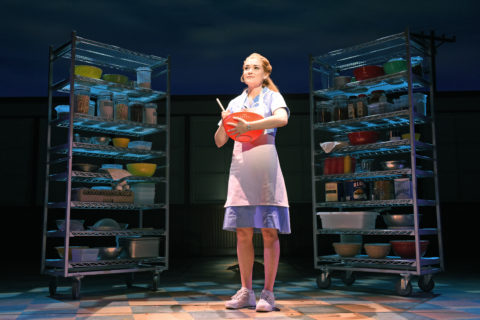
“Waitress,” the hit Broadway musical now playing at the Golden Gate Theater on its first national tour, opens with a chiming refrain: “Sugar, sugar, butter/Sugar, butter, flour.”
Cooed by the titular server, Jenna (Christine Dwyer), and angelically doubled by unseen female ensemble members, these sweet but eerily sung phrases resurface throughout the show.
They’re intended to evoke a quasi-spiritual force that flows through Jenna, giving her inner strength, resilience, and the ability to spread essential goodness in the form of the kick-ass pies she bakes every day. (While far more accurate, “Baker/Waitress” doesn’t cut it as a title).
Audience members resistant to quasi-spiritual forces and insistent, flimsy cheer will find the burrowing earworm of this chant—along with much of “Waitress” —more irksome than winsome.
“Sugar, sugar, butter/Sugar, butter, flour” works fine as an audio signature, like the welcoming hum of a Mac powering up or NBC’s three-note doorbell. It leads you to think something more substantive will follow. So it’s a problem that this sonic trademark proves the most memorable musical element in “Waitress.”
Ironically, Sara Bareilles, a first-time theater composer better known as a pop artist, hangs far too too much of “Waitress” on a single killer hook. The bulk of her country-tinged score blurs together in a gauzy, mid-tempo yawn.
Bareilles struggles with lyrics too, getting pie-eyed on culinary wordplay (“What’s Inside,” “It Only Takes A Taste,” “What Baking Can Do”) and mixing metaphors like a KitchenAid: “If pies were books/Yours would be Shakespeare’s letters.”
And while the music of “Waitress” could use a little more sticky pop influence, the show’s book, by Jessie Nelson—closely adhering to Adrienne Shelly’s 2007 screenplay, could use a lot less. Its plot, setting, and characters come right out of a sit-com. A specific sit-com: “Alice.”
Like “Waitress,” that 1976-1985 television series was built around three staffers at a southern roadside diner: The snappy, uninhibited one (Flo on TV, Becky here), the ditzy, mousy eccentric (Vera, now Dawn), and the sensible, warmhearted leading lady (Alice, Jena’s progenitor). Their superficially gruff teddy bear of a boss has had his name changed from Mel to Cal.
The central trio of “Alice,” led by Broadway veteran Linda Lavin, brought highly textured detail to their roles, giving that show a then-innovative lens on independent working-class women. The writing and performances in this production of “Waitress” leave the threesome relatively flat and flavorless. Nelson tries to spice them up with pinches of sass and sexual empowerment but these get lost in blander batter. Jenna, who has a penchant for cute confectionary names might describe their collective presence as an oversized slice of Exponentially Vanilla Pie.
The 11’o’clock number, “She Used to Be Mine,” finds a pregnant Jenna planning to leave her husband and raise their child on her own. Its written as a crescendoing anthem of self-reckoning, regret and revival. Dwyer’s vocal range and power impress, but she brings across very little sense of Jenna’s inner emotional conflict or evolution. Her head remains hunched into her shoulders, her facial expression static. The performance is notable as singing, but doesn’t take us into the heart of a specific character.The greatest strength—and hence the biggest problem—in a production ostensibly dedicated to female empowerment is that the featured male performers are far and away its most exciting elements.
As Dr. Pomater, Jenna’s gynecologist, confidant and extramarital paramour, Bryan Fenkart exudes irresistible neurotic charm, literally falling over himself to charm her, with a bravura comic physicality that brings Buster Keaton to mind. In one number, Loren Lattaro’s choreography transforms an examination table into Pomater’s pommel horse, bringing a welcome surge of grins and adrenaline to the audience. (Unfortunately, there’s plenty of less successful choreography throughout when Lattaro and director Diane Paulus try to evoke the “Waitress” movie’s occasional moments of magic realism by having ensemble members engage in incongruous Pilobolus-style wriggling).

Christina Dwyer as Jenna
Jeremy Morse, playing Dawn’s kooky beau Ogie, explodes onto the stage with rib-tickling energy and ridiculous tics. With fancy footwork, motormouthed poetry, and loose-hinged limbs, he’s a potent, fizzing human cocktail: Equal parts Donald O’Connor and Leslie Jordan with a splash of Red Skelton. For the length of his first act showcase, “Never Ever Getting Rid of Me,” Morse doesn’t steal the show, he steals the audience, taking them to a jolly, high-altitude escapist place altogether different than “Waitress”’ generally pleasant-enough plateau. It’s a fleeting moment of inverse buzzkill, an incongruous taking of the cake in a pie shop.
Even the smaller male roles, diner manager Cal (Ryan G. Dunkin), Jenna’s abusive husband Earl (Matt DeAngelis, genuinely terrifying, yet soulful) and curmudgeonly diner owner Joe (a sparkling Larry Marshall) are rendered with more authentic detail than the female characters intended to be the story’s center.
Toward show’s end, the plot turns into a diner-unworthy hash: After anguishing for years over Earl’s controlling, violent domestic terrorism, Jenna gives him a simple shoo-fly and he compliantly disappears.
It takes just a minute for her to trim beloved Dr. Pomater out of her life, like a bit of excess pastry on a pie tin. And instead of ever competing for the life-changing prize money in the county bake-off she’s fixated on for the length of the show, Jenna doesn’t transform her life for herself, she lucks into a ridiculous deep dish pious ex machina.
Like Joe, the show’s twinkle-eyed diner owner, I may strike you as crusty in my opinions. “Waitress” has a woman-centric spirit , doesn’t it? Its the first Broadway musical with an all-female creative team, yes? It has pop star pedigree, right? That’s all very á la mode. And like sugar, butter and flour, these ingredients can be combined to great success. But you need a solid recipe. And you can’t serve it half-baked.
